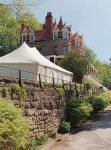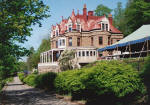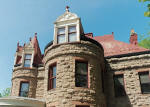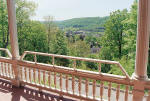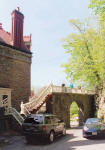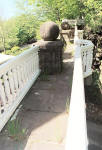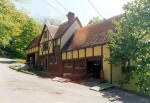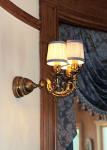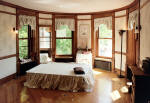|
The Burrell Mansion Little Falls, NY |
"It was just 100 years ago that American ingenuity developed oil heat as a practical reality. On August 11, 1885, the Patent Office granted to David H. Burrell of Little Falls, New York, a patent for the first technically sound oil burner -- a furnace that could burn liquid and gaseous fuels."Presidential Proclamation, "Oil Heat Centennial Year" October 9, 1985 President Ronald Reagan
The D. H. Burrell Co. was founded in 1885 to design, develop, manufacture and distribute dairy apparatus and supplies. Perhaps its best known product was the Burrell Milking Machine. In 1985, in an official proclamation, President Ronald Reagan declared the year "Oil Heat Centennial Year" because it marked 100 years since the U.S. Patent Office granted "...to David H. Burrell of Little Falls, New York, a patent for the first technically sound oil burner -- a furnace that could burn liquid and gaseous fuels." Burrell's invention made possible the entire oil heat industry as we know it today. Burrell's residence, in "Richardsonian Romanesque" style, was designed by Archimedes Russell and completed in 1889. It is built of limestone quarried from a hillside site 500 feet above the Mohawk River. No mortar was used in its construction. The home has 26 rooms and 18,000 square feet of living area. The design included a small self-contained hydroelectric plant, an elevator, an indoor swimming pool and a bowling alley. As you can see below, the home has a commanding view of Little Falls to the south and the countryside beyond. The building stayed in the family for several years after Burrell's death. In recent years the mansion operated as the Overlook Mansion Inn. In May of 2002 everything in the mansion was put up for auction. The first 200 items were simultaneously auctioned on site and over the internet through E-Bay. Items liquidated included everything of value in the home: all furniture, kitchen equipment, even the light fixtures (some of which brought more than $2,000 each). What was left of the mansion was donated to charity. ExteriorInterior |
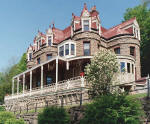 David H. Burrell (1841-1919) made his
fortune as an inventor. His father, Harry Burrell (1797-1879),
founded a cheese business and at the age of 14 David went to work for the
family business. He became a salesman in New York City at age 17. While
traveling abroad to study manufacturing methods he became convinced that
the future development of the dairy products industry lay in improved
equipment.
David H. Burrell (1841-1919) made his
fortune as an inventor. His father, Harry Burrell (1797-1879),
founded a cheese business and at the age of 14 David went to work for the
family business. He became a salesman in New York City at age 17. While
traveling abroad to study manufacturing methods he became convinced that
the future development of the dairy products industry lay in improved
equipment.